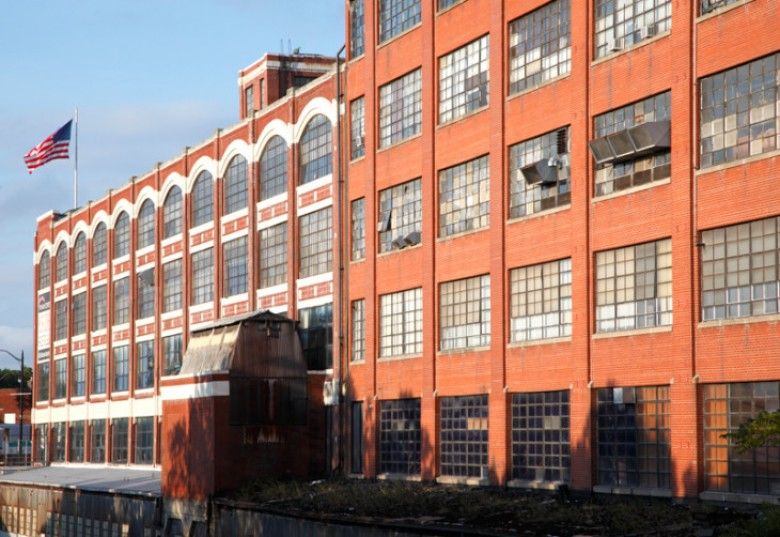The Indoor Street Fair will be lots of fun and there will be plenty of games. Picture this: locally produced video games to play, a hockey slap shot competition, a chalk-walkway to decorate, a Buffalo City Ballet and Aspire dance party, a cappella groups resounding through the immense space, plus more than a dozen vendors.
But this family-friendly, fun event that will rock Tri-Main Center from 11:00am-4:00pm on Saturday, March 12 and benefit Aspire of WNY, is more than just fun and games. There's a century of history and a quarter of a century of preservation to celebrate.
Although it seems as though another industrial building is purchased and repurposed every week in Buffalo these days, this was not the case in the late 1980s. Or in the 1990s. Tri-Main is actually one of the very first re-purposed industrial buildings in the Queen City.
The story begins more than a century ago. The Ford Motor Company opened its four-story factory on Main Street in 1913, right on the Belt Line. Albert Kahn, one of the best known architects of daylight factories, gave the building a terracotta and brick façade, immense windows, and an open floor plan. Model As and Model Ts were built in what would become known as Building 1 for nearly twenty years. Then, in 1931, the building was leased to Bell Aircraft which built the Airacomet P-59, America’s first propeller-less, twin engine jet war plane in great secrecy on the upper floors of the building.
It was also leased to the DNX Corporation, a subsidiary of the Hercules Motor Company, to manufacture diesel engines for the U.S. Navy. The plant ran twenty-four hours a day and produced nearly a million engines for the military and allied armed forces before shutting down operations in 1945. The ediface returned to its automotive roots and became the Trico building when the Trico Products Company, the world’s largest manufacturer of windshield wipers, bought and significantly enlarged the structure in 1945. It was known as Plant 2 for many years.
Trico was founded by John R. Oishei as the Tri-Continental Company in 1917 to manufacture the new-fangled automobile safety features he had invented following a harrowing traffic accident. Windshield wipers caught on quickly and soon became a standard feature on all vehicles. Tri-Continental became Trico, and the Oishei family became some of Buffalo’s most generous philanthropists. However, when the decision was made to move the manufacturing process to Mexico in the mid-1980s, the immense Trico Building hit the market.
In December, 1988, Rae Brothers, Inc. of Toronto, a company known for its restoration of older industrial structures, purchased the 75-year-old building. It’s first, hopeful incarnation was the Market on Main. The Indoor Street Fair harks back to this first non-industrial use of the Trico Building and the first phase of the renovation and re-purposing of the building. When it opened on June 30, 1989, Market on Main included a small farmers market, a flea market and stalls occupied by antique and collectible dealers, an Italian deli, a food market, a florist, a wine shop, a used books stand and stalls for arts and crafts. There was also an entertainment area that featured local talent. Park benches, small carts, street signs and stop lights created a nostalgic feel. Only the first two floors were utilized and the venue was open only on weekends.
Market on Main soon gave way to a bolder vision. Elgin Wolfe and John Rae saw galleries and studios filling the vast, light-filled building, along with small businesses, and even light manufacturing. In 1991, Tri-Main Center became the first large-scale rehabilitation of a vacant industrial complex in the city, turning into something of a business incubator long before there were such thingsand creating a precedent for preservation in Buffalo.
It is quite telling that the very first tenant of the brand new Tri-Main Center was Buffalo Arts Studio, the cooperative studio space for Buffalo artists which still occupies a fascinating corner of the 5th floor twenty-five years later. BAS founder Joanna Angie helped recruit local artists longing for high ceilings, great light and vast wall space, creating a critical mass of creativity in the building. The Jewett Loading Dock beckoned to businesses like Mid-City Office and others who ship and receive regularly.
The ability to create and re-create space in the building by creating and moving walls and doors makes it an agile, malleable space able to accommodate a remarkable spectrum of tenants, from Aspire to WNYCOSH. The renowned Kittinger Furniture Company eventually took over the entire sixth floor in 1996. That space is now being re-purposed for multiple tenants, including Neglia Ballet, just in time for the 25th anniversary of Tri-Main, the ever-changing chameleon on Main Street.
The free-admission Indoor Street Fair is a great way to celebrate Tri-Main's 25th Anniversary and a milestone in Buffalo's burgeoning preservation. Come one, come all!

